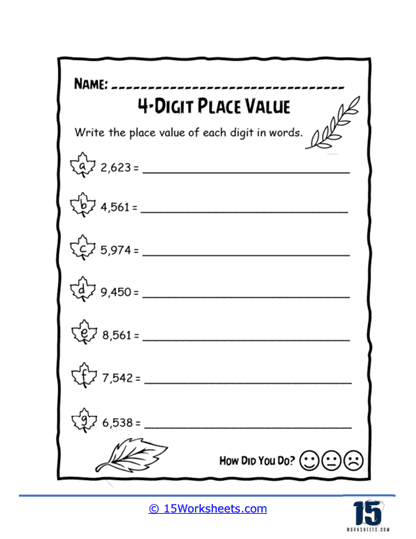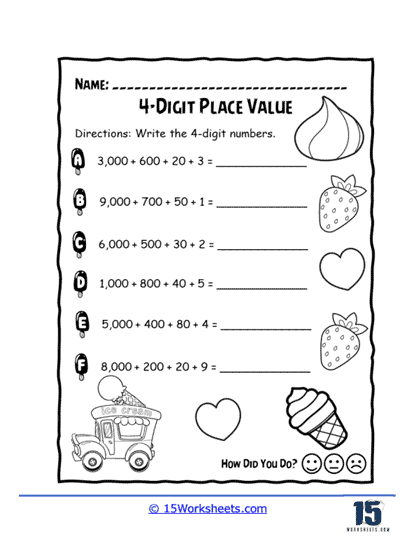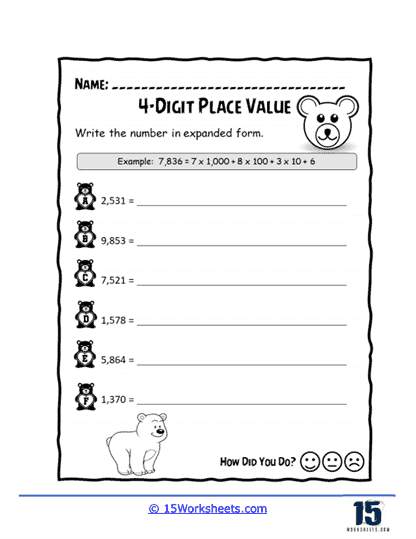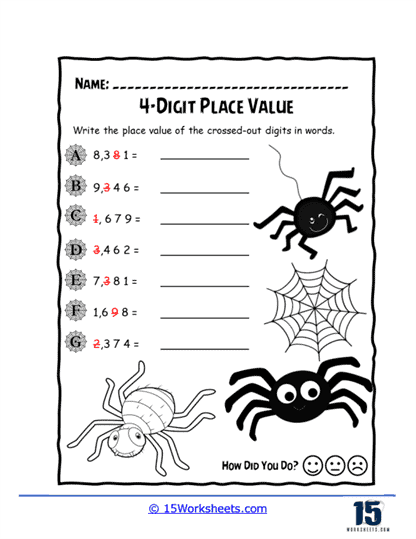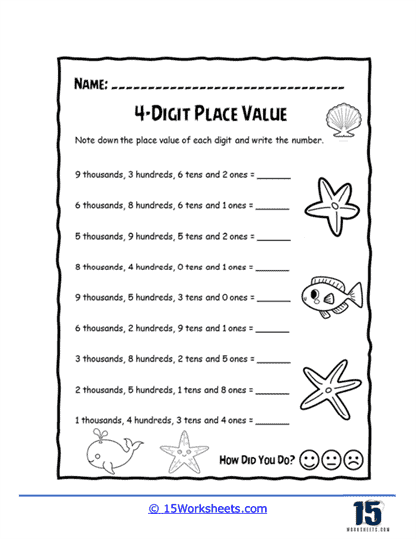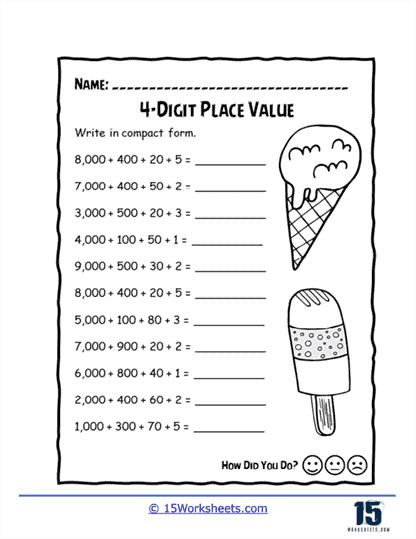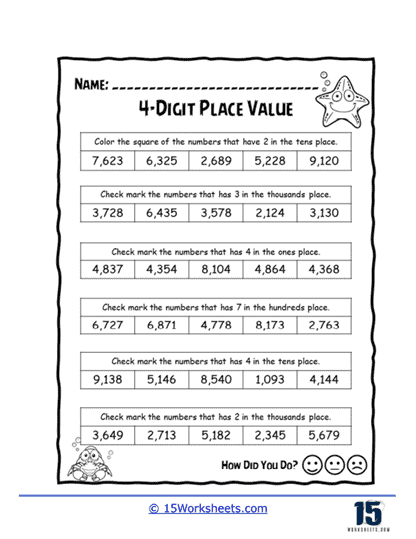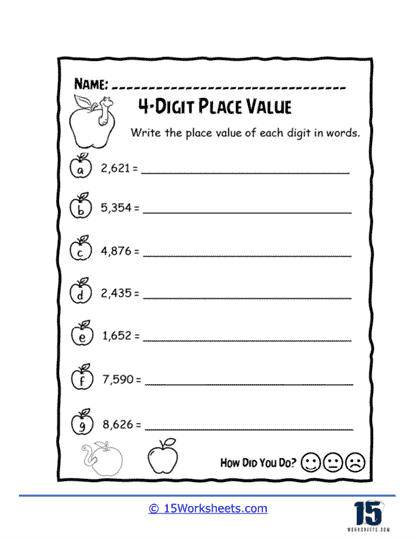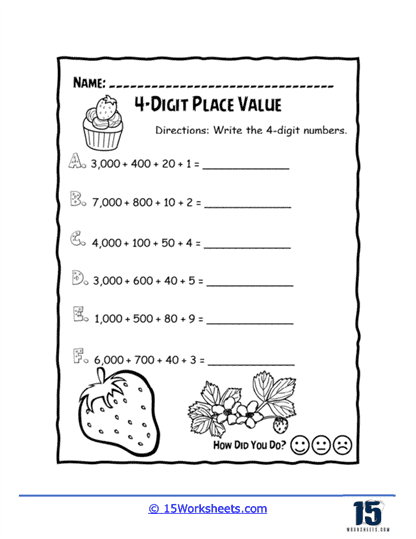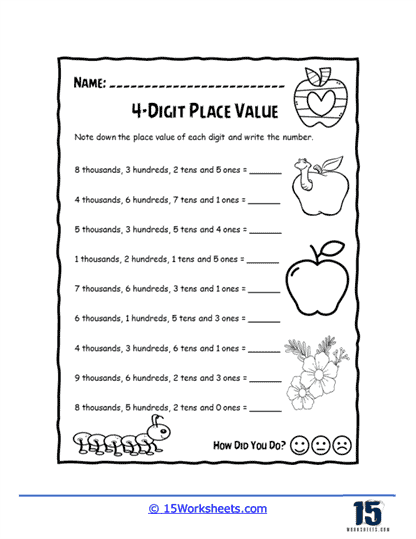4-Digit Place Value Worksheets
About These 15 Worksheets
Imagine you have a magic box with four sections. Each section can hold a number from 0 to 9. These sections represent different places for numbers. This is the concept of “place value.” Just like you have your home address, each digit in a number has its own special address or “place.”
In the world of numbers, each place has its own name. Starting from the right, the places are:
Units (or ones)
Tens
Hundreds
Thousands
Let’s say we have the number 4,328. The ‘8’ is in the units place, the ‘2’ is in the tens place, the ‘3’ is in the hundreds place, and the ‘4’ is in the thousands place. Each of these places has a different value, and that’s why it’s super important to know which number is in which place!
Types of Problems
This collection of worksheets has a unique mix of different types of problems that will help you develop new skills based on this. These are the types of problems that you can expect to find on these sheets:
Identifying Place Values – These problems ask you to name the place of a digit. For example, in the number 4,328, what place is the ‘3’ in? (Answer – Hundreds!)
Finding the Value – Here, you’ll be given a number and a place, and you’ll have to find out the value of the digit in that place. For instance, in the number 4,328, what is the value of the digit in the tens place? (Answer – 20!)
Expanding Numbers – This is like opening up the number to see all its parts. For the number 4,328, you’d write it as 4,000 + 300 + 20 + 8.
Comparing Numbers – Using place values, you can tell which number is bigger or smaller. For example, is 4,328 bigger than 4,299? (Yes, it is!)
Rounding Numbers – Sometimes, we want to simplify numbers to make them easier to work with. For example, rounding 4,328 to the nearest hundred would give 4,300.
Creating Numbers – These problems might ask you to make the largest or smallest number using given digits. For instance, using the digits 7, 3, 5, and 1, the largest number you can make is 7,531 and the smallest is 1,357.
The worksheets will help you develop a wide range of math skill, most directly these skills:
Understanding of Value – By working with these problems, you get a deep understanding of how much each digit is worth based on its place. A ‘5’ in the thousands place is a lot more than a ‘5’ in the tens place!
Logical Thinking – Breaking down numbers, comparing them, or putting them together in a specific way, all require you to think logically and methodically.
Number Sense – You become better friends with numbers. You understand them, can play with them, and can easily see patterns and relationships between them.
Estimation Skills – Rounding numbers helps you make quick and smart guesses. For example, if you’re saving money and you have $4,328, you might think, “That’s close to $4,300.” This helps when planning or making decisions quickly.
What is 4-Digit Place Value?
This refers to the positional value or significance of each digit within a 4-digit number. In a 4-digit number, there are four positions or places, each with its own value. These places, from left to right, are typically labeled as thousands, hundreds, tens, and ones. Here’s a breakdown of the place values in a 4-digit number:
Thousands – This is the leftmost position in a 4-digit number. It represents the thousands place and has a place value of 1,000. The digit in this position indicates how many thousands are in the number.
Hundreds – This is the second leftmost position and represents the hundreds place. It has a place value of 100. The digit in this position tells you how many hundreds are in the number.
Tens – The third position from the left is the tens place, with a place value of 10. The digit in this position indicates how many tens are in the number.
Ones – The rightmost position in a 4-digit number is the ones place, and it has a place value of 1. The digit in this position represents the number of ones in the number.
For example, in the number 3,456:
The digit 3 is in the thousands place, representing 3 thousands (3,000).
The digit 4 is in the hundreds place, representing 4 hundreds (400).
The digit 5 is in the tens place, representing 5 tens (50).
The digit 6 is in the ones place, representing 6 ones (6).
So, the 4-digit number 3,456 can be broken down into thousands, hundreds, tens, and ones using their respective place values.
Where Do We Use These Skills In The Real World?
Shopping – Imagine you’re buying toys and they cost $3,248. If you round it off, you’d think, “Okay, that’s about $3,200.” This helps you quickly decide if you have enough money.
Planning a Trip – If you’re going to a theme park and the total cost is $4,283 for the tickets, food, and souvenirs, using your place value knowledge, you can break down the costs and plan better.
Telling Time – When talking about years, like the year 2023, understanding place value helps you realize that it’s been 23 years since the year 2000.
In Jobs – Many jobs require people to deal with numbers. Builders, bankers, shopkeepers, and even artists sometimes need to measure, calculate, and compare. Understanding place values is the first step to being good with numbers.






